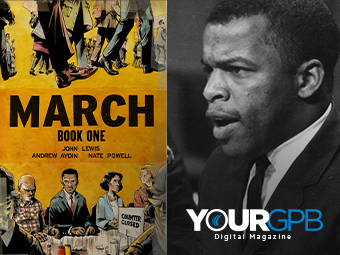
Section Branding
Header Content
Congressman John Lewis Teaches Civil History To A New Generation In Graphic Novel "March"
Primary Content

The following Article is from Your GPB Digital Magazine. Click here to download the iPad App.
To teach the younger generation about the civil rights era, Congressman John Lewis is turning to comic books. He has teamed up with Andrew Aydin, a telecommunications aide in his office, and best-selling comic book artist Nate Powell to write his own, the graphic novel “March.”
“March” is a three book series and is Lewis’ first person account of his experiences fighting for civil and human rights. “Book One” recounts his days growing up in rural Alabama, his life altering meeting with Dr. Martin Luther King Jr., his participation in lunch counter sit-ins and dramatic encounter on the steps of city hall.
Aydin, a comic book fan, proposed the graphic novel idea a few years ago, thinking Lewis’ story should be told in a format that is appealing to young people. Initially the congressman was not sold on it.
“I sort of put it off,” comments Lewis about his reaction to the proposal. But then he thought of how he and other young activists were inspired by the groundbreaking 1950’s comic book “Martin Luther King and the Montgomery Story.”
“My mind went back to 1957, ‘The Montgomery Story,’ telling the story of Martin Luther King, Jr. and the bus boycott, and how they did it with the comics,” says Lewis. “And making it easy for young people to understand the power of nonviolence, the power of direct action, and peaceful resistance.”
“And I finally said, ‘Yes, let’s do it,’ because I saw the need to try to educate and inspire and get more young people motivated to do something about all of the violence in our society and to let them know that during another period in our history that a group of young people had the courage to use the way of peace, the way of love, the way of nonviolence to bring about change. It’s a successful technique, a successful philosophy, and it’s a way out.”
“March” turns Lewis and key figures of the civil rights movement into characters young people can relate to. One section depicts a young, nervous Lewis meeting a down to earth Martin Luther King Jr. They met because Lewis was interested in integrating Troy State University in Alabama and sought King’s help. Lewis was unable to proceed with his plans because his parents did not consent to it. But the comic clearly shows how this pivotal point in his life led Lewis down the path of nonviolent social activism.
Aydin says humanizing Lewis and other historical figures was easy because of how Lewis tells his story.
“So much of this story is based on Congressman Lewis’ words as a storyteller,” reflects Aydin. “It’s a rich oral history that has been put down on paper and brought to life by Nate Powell’s amazing imagery and talent as an artist. I just did the best I could to capture Congressman Lewis’ words in a way that let Nate Powell have what he needed to make his unbelievable art.”
While “March” is not the first time a comic book has been used to tell the story of civil rights, it represents other milestones. It is the first graphic novel authored by a sitting member of Congress. It is also the first graphic novel endorsed by a commander-in-chief - President Bill Clinton.
The book has already enabled Lewis to reach wider, unexpected audiences. In July, he, Aydin and Powell appeared at San Diego Comic-Con, one of the largest comic book conventions in the country. Superhero icons like the “Hulk” tv show actor Lou Ferrigno lined up with young fans to shake hands and get their books signed.
“March” is in bookstores now and is available in both softcover and e-book formats.





